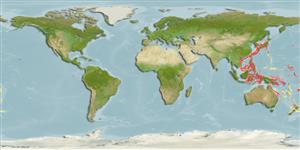>
Anguilliformes (Eels and morays) >
Congridae (Conger and garden eels) > Congrinae
Etymology: Bathycongrus: Greek, bathys = deep + Latin, conger = conger (Ref. 45335).
More on authors: Jordan & Snyder.
Environment: milieu / climate zone / depth range / distribution range
Écologie
marin bathydémersal; profondeur 150 - 450 m (Ref. 7446). Deep-water
Western Pacific: Japan to the Philippines.
Taille / Poids / Âge
Maturity: Lm ? range ? - ? cm
Max length : 54.0 cm TL mâle / non sexé; (Ref. 7446)
Description synthétique
Clés d'identification | Morphologie | Morphométrie
Body moderately elongate. Tail slender, attenuate at tip. Snout bluntly pointed, protruding beyond tip of lower jaw. Preserve specimen, head and body pale brown dorsally, much paler on belly. Caudal fin black, pectoral fin pale (Ref. 37528). Dorsal-fin origin slightly behind anteriormost insertion of pectoral fin to above middle of appressed fin. Preanal lateral line pores 29-32 (Ref. 36324).
Life cycle and mating behavior
Maturité | Reproduction | Frai | Œufs | Fécondité | Larves
Castle, P.H.J. and D.G. Smith, 1999. A reassessment of the eels of the genus Bathycongrus in the Indo-west Pacific. J. Fish Biol. 54(5):973-995. (Ref. 36324)
Statut dans la liste rouge de l'IUCN (Ref. 130435: Version 2024-2)
Menace pour l'homme
Harmless
Utilisations par l'homme
Outils
Articles particuliers
Télécharger en XML
Sources Internet
Estimates based on models
Preferred temperature (Ref.
123201): 1.8 - 18.5, mean 13.6 °C (based on 98 cells).
Phylogenetic diversity index (Ref.
82804): PD
50 = 0.5000 [Uniqueness, from 0.5 = low to 2.0 = high].
Bayesian length-weight: a=0.00063 (0.00029 - 0.00138), b=3.18 (3.00 - 3.36), in cm total length, based on LWR estimates for this (Sub)family-body shape (Ref.
93245).
Niveau trophique (Ref.
69278): 3.9 ±0.5 se; based on size and trophs of closest relatives
Résilience (Ref.
120179): Milieu, temps minimum de doublement de population : 1,4 à 4,4 années (Preliminary K or Fecundity.).
Fishing Vulnerability (Ref.
59153): Moderate vulnerability (42 of 100).
